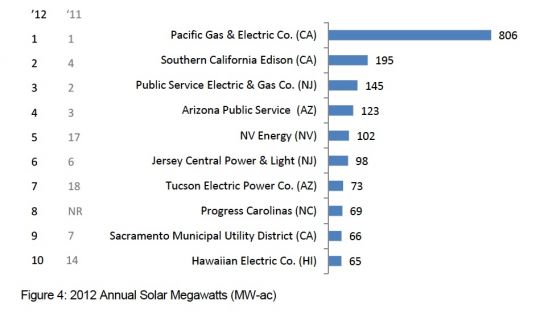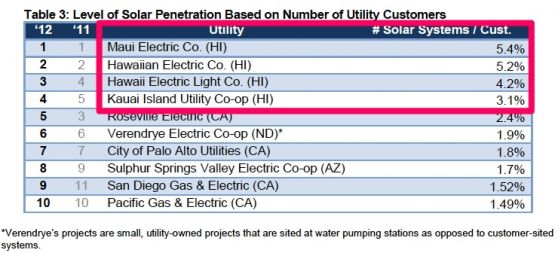When utilities encounter solar power, it's often looked at as a government-mandated charity effort that needs to be tolerated. That's cynical, but not far from the truth -- judging by the sentiments expressed by the leaders of the utility industry at the annual Edison Electric Institute convention this week in San Francisco. (More on that in an article tomorrow.)
So, while electrical utilities celebrate dividend and tax rulings when they are amongst their brethren, they do their best to show off their solar assets when the opportunity presents itself.
SEPA just released its Solar Electric Power Association 2012 Top 10 Utility Solar Rankings Report. Here are the takeaways from the U.S. solar market:
- U.S. utilities tallied record solar capacity of more than 2,000 megawatts (AC) in 2012. The U.S. has more than 300,000 solar installations and more than 6 gigawatts (AC) deployed across the nation.
- Market share for large-scale (> 5 megawatts) solar grew 160 percent to 1,130 megawatts from 2011 to represent 46 percent of all annual solar capacity in about 70 solar projects.
- Utilities interconnected almost 90,000 net-metered projects totaling 1,151 megawatts (AC) in 2012 -- a 46 percent growth rate over 2011. There are currently about 3.5 gigawatts of net-metered projects in the country, about 80 percent of which are found in California, New Jersey, Arizona, Hawaii and Massachusetts.
- No concentrating solar power (CSP) projects were finished in 2012, but at least six projects totaling 750 megawatts are under construction and slated for 2013.

Pacific Gas and Electric (PG&E) kept its top spot for the fifth year in a row in the annual solar megawatts rankings with a total of 806 megawatts installed in 2012. In 2012, there were twenty utilities that integrated 20 megawatts or more on an annual basis. PG&E also ranked first in cumulative installed solar. Sacramento Municipal Utility District (SMUD) was the only municipal utility to make the national rankings at 9th overall, with 66 megawatts of solar integrated.
The Top 10 utilities have nearly 200,000 solar installations.

Hawaiian utilities win the solar penetration contest with ease. Penetration rate, defined as the number of solar systems per customer rather than the solar capacity per customer, shows Maui Electric Company with about 5.4 percent of its customer-base with a solar system, followed by Hawaiian Electric Company, Hawaii Electric Light Company and Kauai Island Utility Cooperative.

SEPA Outlook for 2013
- Large-scale solar will continue its growth in overall capacity in 2013. This market segment could add 3 to 3.5 gigawatts of new generation.
- Net-metered projects will continue to expand
- SEPA and Navigant Consulting estimate that the average installed costs of utility-scale projects will fall to the $2.00 per watt range, while commercial projects will average closer to $3.00 per watt.
- SEPA expects new utilities may rise into the Top 10 rankings in 2013. SEPA’s 2013 utility watch list includes Indianapolis Power & Light, Georgia Power, and the Imperial Irrigation District.
Download the full report here.



